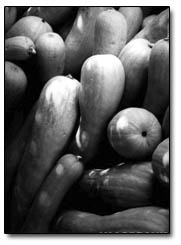 In
September, I become slave to my garden. Each night I pull
scrappy blankets, old sleeping bags, towels, shower curtains
and holey sheets off our clothesline. With the grab bag of
materials slung over my shoulder, or often dragging behind
me, I trudge down the garden rows covering each and every
tender vegetable. Tomatoes, jalapeF1os, cucumbers, squash
and basil each get tucked in tight, protected from the oncoming
frost.
In
September, I become slave to my garden. Each night I pull
scrappy blankets, old sleeping bags, towels, shower curtains
and holey sheets off our clothesline. With the grab bag of
materials slung over my shoulder, or often dragging behind
me, I trudge down the garden rows covering each and every
tender vegetable. Tomatoes, jalapeF1os, cucumbers, squash
and basil each get tucked in tight, protected from the oncoming
frost.
Some nights I stand in the twilight garden, fingers, nose
and mouth distilling the night air into a preordained number,
35F, surely it won’t get below 35F tonight, 34F at the
lowest; I apply this number to the cloud cover quotient, figuring
I have at least as good a chance as the weather report in
predicting the nighttime lows for my own rectangle of microclimate.
From this subtle equation, I decide whether to cover the garden.
Lately though, I’ve been taking no chances; I want every
last fruit that spangles our bushes of tomatoes. And I want
them red and sweet with juice.
This is always the farmer’s plight in high-elevation
Colorado.
It might not sound so bad were it only a few scattered days
in September that my garden looked like an outdoor laundromat,
myself twice a scurrying to cover and uncover. But you must
know that this frost danger occurs in the spring as well.
I don’t know if it’s worse to have your indoor-sprouted
starts, full of promise and possibility for the coming season,
freeze in June, or your old, weathered plants, taunting you
with half ripe fruit, die before their time in September.
I’ve experienced both.
As the fall equinox comes in scarlet oaks and golden aspens,
I walk through the garden trimming frost-scarred tomato and
squash leaves. And it seems I’ve forgotten a whole category
of plants: the humble, frost-tolerant gems. How I give thanks
for the broccoli, green florets still bursting from the stalk
with no nighttime amendments needed. The cabbage heads, split
open from the rainy season, are growing steadily, slated for
sauerkraut, though in no particular hurry for harvest. The
frost-sweetened carrots are underground treasures that we
pull as needed, easily braving the average low of 30 degrees.
The potatoes, herbs, sunflowers, chard, bok choi, and kale
are troopers, making it through every frostbitten night with
no protection. The lettuce freezes every night, its watery
insides turning to a frozen mush; and then miraculously by
sun-brightened 10 a.m., these same leaves have restored themselves,
crisp and ready for a fresh lunchtime salad. These cold-hardy
plants seem to laugh as I uncover the sleepy, sheltered tomatoes
each morning, lifting the lumpy sleeping bag that still bears
my name in indelible ink from Camp Cazadero.
There is a relief to the fall garden. By the equinox, late
September, I’ve let the zucchini, yellow crookneck squash
and the cucumbers go. I’ve harvested all the jalapeF1os
and most of the winter squash. The only plants I still answer
to are the tomatoes. With fewer plants in the ground, days
shorter and the heat less intense, water needs have diminished.
The weeds have given up their will to live, and I’ve
given up my will to keep them down. The grasshopper fleets
are now represented by one or two sluggish members that give
a half-hearted hop out from underfoot in the morning, a small
threat.
Finally, there is some rest for the summer-weary gardener
– except for the tiny new lettuce and chard sprouts
that have just popped up. I need to create a cold frame cover
so they can spend their winter growing in comfort.
– Rachel Turiel Hinds

